Time-Lagged Correlation between Soil Moisture and Intra-Annual Dynamics of Vegetation on the Mongolian Plateau
Abstract
1. Introduction
2. Materials and Methods
2.1. Study Area
2.2. Data Sources
2.3. Methods
2.3.1. Data Smoothing and Up-Sampling
2.3.2. Time-Lagged Correlation Analysis
2.3.3. Defining the Different Stages of Vegetation Change
3. Results
3.1. Spatiotemporal Distribution of the Soil Moisture in Mongolian Plateau (MP)
3.1.1. Spatial Distribution of the Soil Moisture at Various Depth
3.1.2. Temporal Distribution of the Soil Moisture at Various Depth
3.2. Spatial Characteristics of the Time-Lagged Correlation between NDVI and Soil Moisture
3.3. Temporal Characteristics of the Time-Lagged Correlation between NDVI and Soil Moisture
3.3.1. Variations Trend of NDVI and Soil Moisture at Different Stages of Vegetation Change
3.3.2. Time-Lagged Correlation between the NDVI and Soil Moisture at Different Stage of Vegetation Changes
4. Discussion
4.1. Spatiotemporal Characteristics of the Soil Moisture in MP
4.2. Relationship between the Soil Moisture and NDVI in MP
5. Conclusions
Author Contributions
Funding
Institutional Review Board Statement
Informed Consent Statement
Data Availability Statement
Conflicts of Interest
References
- Legates, D.R. Soil moisture: A central and unifying theme in physical geography. Prog. Phys. Geogr. 2011, 35, 65–86. [Google Scholar] [CrossRef]
- Yang, L.; Wei, W.; Chen, L.; Chen, W.; Wang, J. Response of temporal variation of soil moisture to vegetation restoration in semi-arid Loess Plateau, China. Catena 2014, 115, 123–133. [Google Scholar] [CrossRef]
- Engstrom, R.; Hope, A.; Kwon, H.; Stow, D. The Relationship Between Soil Moisture and NDVI Near Barrow, Alaska. Phys. Geogr. 2008, 29, 38–53. [Google Scholar] [CrossRef]
- Hupet, F.; Vanclooster, M. Intraseasonal dynamics of soil moisture variability within a small agricultural maize cropped field. J. Hydrol. 2002, 261, 86–101. [Google Scholar] [CrossRef]
- Wu, W.; Geller, M.A.; Dickinson, R.E. The Response of Soil Moisture to Long-Term Variability of Precipitation. J. Hydrometeorol. 2002, 3, 604–613. [Google Scholar] [CrossRef]
- Wang, A.; Shi, X. A Multilayer Soil Moisture Dataset Based on the Gravimetric Method in China and Its Characteristics. J. Hydrometeorol. 2019, 20, 1721–1736. [Google Scholar] [CrossRef]
- Coenders-Gerrits, A.M.J.; Van Der Ent, R.J.; Bogaard, T.A.; Wang-Erlandsson, L.; Hrachowitz, M.; Savenije, H.H.G. Uncertainties in transpiration estimates. Nat. Cell Biol. 2014, 506, E1–E2. [Google Scholar] [CrossRef] [PubMed]
- Chang, L.L.; Dwivedi, R.; Knowles, J.F.; Fang, Y.H.; Niu, G.Y.; Pelletier, J.D.; Rasmussen, C.; Durcik, M.; Barron-Gafford, G.A.; Meixner, T. Why Do Large-Scale Land Surface Models Produce a Low Ratio of Transpiration to Evapotranspiration? J. Geophys. Res. Atmos. 2018, 123, 9109–9130. [Google Scholar] [CrossRef]
- Aranda, I.; Forner, A.; Cuesta, B.; Valladares, F. Species-specific water use by forest tree species: From the tree to the stand. Agric. Water Manag. 2012, 114, 67–77. [Google Scholar] [CrossRef]
- Cubera, E.; Moreno, G. Effect of land-use on soil water dynamic in dehesas of Central-Western Spain. Catena 2007, 71, 298–308. [Google Scholar] [CrossRef]
- Wang, L.; Wang, X.; Chen, L.; Song, N.-P.; Yang, X.-G. Trade-off between soil moisture and species diversity in semi-arid steppes in the Loess Plateau of China. Sci. Total Environ. 2021, 750, 141646. [Google Scholar] [CrossRef] [PubMed]
- Wang, X.; Xie, H.; Guan, H.; Zhou, X. Different responses of MODIS-derived NDVI to root-zone soil moisture in semi-arid and humid regions. J. Hydrol. 2007, 340, 12–24. [Google Scholar] [CrossRef]
- Bounoua, L.; Collatz, G.J.; Los, S.O.; Sellers, P.J.; Dazlich, D.A.; Tucker, C.J.; Randall, D.A. Sensitivity of Climate to Changes in NDVI. J. Clim. 2000, 13, 2277–2292. [Google Scholar] [CrossRef]
- Buermann, W.; Dong, J.; Zeng, X.; Myneni, R.B.; Dickinson, R.E. Evaluation of the Utility of Satellite-Based Vegetation Leaf Area Index Data for Climate Simulations. J. Clim. 2001, 14, 3536–3550. [Google Scholar] [CrossRef]
- Asbjornsen, H.; Goldsmith, G.R.; Alvarado-Barrientos, M.S.; Rebel, K.; Osch, F.P.V.; Rietkerk, M.; Chen, J.; Gotsch, S.; Tobón, C.; Geissert, D.R.; et al. Ecohydrological advances and applications in plant-water relations research: A review. J. Plant Ecol. 2011, 4, 3–22. [Google Scholar] [CrossRef]
- Asbjornsen, H.; Ashton, M.S.; Vogt, D.J.; Palacios, S. Effects of habitat fragmentation on the buffering capacity of edge environments in a seasonally dry tropical oak forest ecosystem in Oaxaca, Mexico. Agric. Ecosyst. Environ. 2003, 103, 481–495. [Google Scholar] [CrossRef]
- Potts, D.L.; Scott, R.L.; Bayram, S.; Carbonara, J. Woody plants modulate the temporal dynamics of soil moisture in a semi-arid mesquite savanna. Ecohydrology 2010, 3, 20–27. [Google Scholar] [CrossRef]
- Wang, G.; Shen, Y.; Qian, J.; Wang, J. Study on the Influence of Vegetation Change on Soil Moisture Cycle in Alpine Meadow. J. Glaciol. Geocryol. 2003, 25, 653–659. [Google Scholar]
- Zhang, Z.; Wu, G.; Wang, D.; Deng, L.; Hao, H.; Yang, Z.; Shangguan, Z. Plant com m unity structure and soilm oisture in the sem i -arid naturalgrassland of the Loess Plateau. Acta Partaculturae Sin. 2014, 23, 313–319. [Google Scholar]
- Asbjornsen, H.; Shepherd, G.; Helmers, M.; Mora, G. Seasonal patterns in depth of water uptake under contrasting annual and perennial systems in the Corn Belt Region of the Midwestern, U.S. Plant Soil 2008, 308, 69–92. [Google Scholar] [CrossRef]
- Lu, N.; Chen, S.; Wilske, B.; Sun, G. Evapotranspiration and soil water relationships in a range of disturbed and undisturbed ecosystems in the semi-arid Inner Mongolia, China. J. Plant Ecol. 2011, 4, 49–60. [Google Scholar] [CrossRef]
- Schwinning, S. The ecohydrology of roots in rocks. Ecohydrology 2010, 3, 238–245. [Google Scholar] [CrossRef]
- Zhang, Y.; Huang, D.; Zhao, X.; Zhao, S. Study on the potential evapotranspiration of grassland in the north slope of Qilianshan Mountain. J. Anhui Agric. Sci. 2008, 36, 8403–8405. [Google Scholar]
- Volpe, V.; Marani, M.; Albertson, J.D.; Katul, G. Root controls on water redistribution and carbon uptake in the soil-plant system under current and future climate. Adv. Water Resour. 2013, 60, 110–120. [Google Scholar] [CrossRef]
- Su, B.; Shangguan, Z. Decline in soil moisture due to vegetation restoration on the Loess Plateau of China. Land Degrad. Dev. 2019, 30, 290–299. [Google Scholar] [CrossRef]
- Jia, X.; Shao, M.; Zhu, Y.; Luo, Y. Soil moisture decline due to afforestation across the Loess Plateau, China. J. Hydrol. 2017, 546, 113–122. [Google Scholar] [CrossRef]
- Mao, J.; Nierop, K.G.J.; Damsté, J.S.S.; Dekker, S.C. Roots induce stronger soil water repellency than leaf waxes. Geoderma 2014, 232–234, 328–340. [Google Scholar] [CrossRef]
- Santiago, L.S.; Goldstein, G.; Meinzer, F.C.; Fisher, J.B.; Machado, K.; Woodruff, D.; Jones, T. Leaf photosynthetic traits scale with hydraulic conductivity and wood density in Panamanian forest canopy trees. Oecologia 2004, 140, 543–550. [Google Scholar] [CrossRef]
- Krauss, K.W.; Young, P.J.; Chambers, J.L.; Doyle, T.W.; Twilley, R.R. Sap flow characteristics of neotropical mangroves in flooded and drained soils. Tree Physiol. 2007, 27, 775–783. [Google Scholar] [CrossRef] [PubMed][Green Version]
- Bao, G.; Bao, Y.; Qin, Z.; Xin, X.; Bao, Y.; Bayarsaikan, S.; Zhou, Y.; Chuntai, B. Modeling net primary productivity of terrestrial ecosystems in the semi-arid climate of the Mongolian Plateau using LSWI-based CASA ecosystem model. Int. J. Appl. Earth Obs. Geoinf. 2016, 46, 84–93. [Google Scholar] [CrossRef]
- Guo, L. Analyses the Soil Moisture of Mongolia Plateau with MODIS-TVDI MODEL and AMSR-E Data. Master’s Thesis, Inner Mongolia Normal University, Hohhot, China, 2010. [Google Scholar]
- Wei, B.; Shan, Y.; Jia, X.; Bao, Y.; Na, R.; Yin, S. Analysis of soil moisture retrieval and response to meteorological factors using AMSR-2. Chin. J. Eco-Agric. 2016, 24, 837–845. [Google Scholar]
- Munkhtsetseg, E.; Shinoda, M.; Gillies, J.A.; Kimura, R.; King, J.; Nikolich, G. Relationships between soil moisture and dust emissions in a bare sandy soil of Mongolia. Particuology 2016, 28, 131–137. [Google Scholar] [CrossRef]
- Maria, E.; Fernandez-Gimenez, B.; Allen, D. Testing a non-equilibrium model of rangeland vegetation dynamics in Mongolia. J. Appl. Ecol. 1999, 36, 871–885. [Google Scholar] [CrossRef]
- Li, A.; Wu, J.; Huang, J.J.L.E. Distinguishing between human-induced and climate-driven vegetation changes: A critical application of RESTREND in inner Mongolia. Landsc. Ecol. 2012, 27, 969–982. [Google Scholar] [CrossRef]
- Li, C.; Wang, J.; Hu, R.; Yin, S.; Bao, Y.; Ayal, D.Y. Relationship between vegetation change and extreme climate indices on the Inner Mongolia Plateau, China, from 1982 to 2013. Ecol. Indic. 2018, 89, 101–109. [Google Scholar] [CrossRef]
- Wang, J.F.; Zhang, T.L.; Fu, B.J. A measure of spatial stratified heterogeneity. Ecol. Indic. 2016, 67, 250–256. [Google Scholar] [CrossRef]
- Guo, E.; Wang, Y.; Wang, C.; Sun, Z.; Li, H. NDVI Indicates Long-Term Dynamics of Vegetation and Its Driving Forces from Climatic and Anthropogenic Factors in Mongolian Plateau. Remote Sens. 2021, 13, 688. [Google Scholar] [CrossRef]
- Kang, J.; Bao, G.; Wu, L.; Zhang, W.; Jiang, L.; Liu, C. Variations in spring phenology of different vegetation types in the Mongolian Plateau and its responses to climate change during 2001–2017. Chin. J. Ecol. 2019, 38, 2490–2499. [Google Scholar]
- Deng, Y.; Wang, S.; Bai, X.; Wu, L.; Cao, Y.; Li, H.; Wang, M.; Li, C.; Yang, Y.; Hu, Z.; et al. Comparison of soil moisture products from microwave remote sensing, land model, and reanalysis using global ground observations. Hydrol. Process. 2020, 34, 836–851. [Google Scholar] [CrossRef]
- Kim, H.; Wigneron, J.P.; Kumar, S.; Dong, J.; Wagner, W.; Cosh, M.H.; Lakshmi, V. Global scale error assessments of soil moisture estimates from microwave-based active and passive satellites and land surface models over forest and mixed irrigated/dryland agriculture regions. Remote Sens. Environ. 2020, 251, 112052. [Google Scholar] [CrossRef]
- Pinzon, J.E.; Tucker, C.J. A Non-Stationary 1981–2012 AVHRR NDVI3g Time Series. Remote Sens. 2014, 6, 6929–6960. [Google Scholar] [CrossRef]
- Wang, J.; Dong, J.; Liu, J.; Huang, M.; Li, G.; Running, S.W.; Smith, W.K.; Harris, W.; Saigusa, N.; Kondo, H.; et al. Comparison of gross primary productivity derived from GIMMS NDVI3g, GIMMS, and MODIS in Southeast Asia. Remote Sens. 2014, 6, 2108–2133. [Google Scholar] [CrossRef]
- Atkinson, P.M.; Jeganathan, C.; Dash, J.; Atzberger, C. Inter-comparison of four models for smoothing satellite sensor time-series data to estimate vegetation phenology. Remote Sens. Environ. 2012, 123, 400–417. [Google Scholar] [CrossRef]
- Zhang, C.; Lei, T.; Song, D. Analysis of temporal and spatial characteristics of time lag correlation between the vegetation cover and soil moisture in the Loess Plateau. Acta Ecol. Sin. 2018, 38, 2128–2138. [Google Scholar]
- Zhang, X.; Friedl, M.A.; Schaaf, C.B.; Strahler, A.H.; Hodges, J.C.F.; Gao, F.; Reed, B.C.; Huete, A. Monitoring vegetation phenology using MODIS. Remote Sens. Environ. 2003, 84, 471–475. [Google Scholar] [CrossRef]
- Hou, X.; Gao, S.; Niu, Z.; Xu, Z. Extracting grassland vegetation phenology in North China based on cumulative spot-vegetation NDVI data. Int. J. Remote Sens. 2014, 35, 3316–3330. [Google Scholar] [CrossRef]
- Wu, C.; Hou, X.; Peng, D.; Gonsamo, A.; Xu, S. Land surface phenology of China’s temperate ecosystems over 1999–2013: Spatial-temporal patterns, interaction effects, covariation with climate and implications for productivity. Agric. For. Meteorol. 2016, 216, 177–187. [Google Scholar] [CrossRef]
- Bao, G.; Chen, J.; Chopping, M.; Bao, Y.; Bayarsaikhan, S.; Dorjsuren, A.; Tuya, A.; Jirigala, B.; Qin, Z. Dynamics of net primary productivity on the Mongolian Plateau: Joint regulations of phenology and drought. Int. J. Appl. Earth Obs. Geoinf. 2019, 81, 85–97. [Google Scholar] [CrossRef]
- Zhang, Z.; Shao, H.; Xu, P.; Chu, L.; Lu, Z.; Tian, J. On evolution and perspectives of bio-watersaving. Colloids Surf. B Biointerfaces 2007, 55, 1–9. [Google Scholar] [CrossRef]
- Zhao, Z.; Shen, Y.; Wang, Q.; Jiang, R. The temporal stability of soil moisture spatial pattern and its influencing factors in rocky environments. Catena 2020, 187, 104418. [Google Scholar] [CrossRef]
- Seneviratne, S.I.; Corti, T.; Davin, E.L.; Hirschi, M.; Jaeger, E.B.; Lehner, I.; Orlowsky, B.; Teuling, A.J. Investigating soil moisture–climate interactions in a changing climate: A review. Earth Sci. Rev. 2010, 99, 125–161. [Google Scholar] [CrossRef]
- Teuling, A.J.; Troch, P.A. Improved understanding of soil moisture variability dynamics. Geophys. Res. Lett. 2005, 32, L05404. [Google Scholar] [CrossRef]
- Guber, A.K.; Gish, T.J.; Pachepsky, Y.A.; Genuchten, M.T.V.; Daughtry, C.S.T.; Nicholson, T.J.; Cady, R.E. Temporal stability in soil water content patterns across agricultural fields. Catena 2007, 73, 125–133. [Google Scholar] [CrossRef]
- Pachepsky, Y.A.; Guber, A.K.; Jacques, D. Temporal persistence in vertical distribution of soil moisture contents. Soil Sci. Soc. Am. J. 2005, 69, 347–352. [Google Scholar] [CrossRef]
- Vanderlinden, K.; Pachepsky, Y.A.; Pederera-Parrilla, A.; Martínez, G.; Espejo-Pérez, A.J.; Perea, F.; Giráldez, J.V. Water Retention and Preferential States of Soil Moisture in a Cultivated Vertisol. Soil Sci. Soc. Am. J. 2017, 81, 1–9. [Google Scholar] [CrossRef]
- Caldwell, M.M.; Richards, J.H. Hydraulic lift: Water efflux from upper roots improves effectiveness of water uptake by deep roots. Oecologia 1989, 79, 1–5. [Google Scholar] [CrossRef] [PubMed]
- Dawson, T.E. Hydraulic lift and water use by plants: Implications for water balance, performance and plant-plant interactions. Oecologia 1993, 95, 565–574. [Google Scholar] [CrossRef] [PubMed]
- Horton, J.L.; Hart, S.C. Hydraulic lift: A potentially important ecosystem process. Trends Ecol. Evol. 1998, 8, 232–235. [Google Scholar] [CrossRef]
- Georg, J.; Helmut, S.; Herbert, H.; Gerhard, M.; Bernhard, K. A hillslope scale comparison of tree species influence on soil moisture dynamics and runoff processes during intense rainfall. J. Hydrol. 2012, 420, 112–124. [Google Scholar]
- Koster, R.D.; Dirmeyer, P.A.; Guo, Z.; Bonan, G.; Chan, E.; Cox, P.; Gordon, C.T.; Kanae, S.; Kowalczyk, E.; Lawrence, D.; et al. Regions of Strong Coupling Between Soil Moisture and Precipitation. Science 2004, 305, 1138–1140. [Google Scholar] [CrossRef]
- Li, H.; Wang, M.; Chai, B. Spatial and temporal characteristics of soil moisture dynamics in Loess Plateau. J. Appl. Ecol. 2003, 14, 14. [Google Scholar]
- Zhang, Y.; Zhang, G. The analysis of soil moisture over typical mesa in the Chinese Loess Plateau. J. Arid Land Resour. Environ. 2010, 24, 190–195. [Google Scholar]
- Liu, L.; Li, A.H.; Bao, Y.J.; Zhang, J.; Baoyin, T.; Zhou, Y.L. The corresponding relationship between the vertical root distribution of grassland communities and steppe degradation stage. Chin. J. Grassl. 2018, 40, 93–98. [Google Scholar]
- Nathaly, R.G.; Mommer, L.; Grégoire, T.F.; Iversen, C.; Weigelt, A. Global root traits (groot) database. Glob. Ecol. Biogeogr. 2020, 30, 25–37. [Google Scholar]
- Entin, J.K.; Robock, A.; Vinnikov, K.Y.; Hollinger, S.E.; Liu, S.; Namkhai, A. Temporal and spatial scales of observed soil moisture variations in the extratropics. J. Geophys. Res. Atmos. 2000, 105, 11865–11877. [Google Scholar] [CrossRef]
- Pielke, R.A., Sr.; Avissar, R.; Raupach, M.; Dolman, A.J.; Zeng, X.; Denning, A.S. Interactions between the atmosphere and terrestrial ecosystems: Influence on weather and climate. Glob. Chang. Biol. 1998, 4, 461–475. [Google Scholar] [CrossRef]
- Yang, W. Division of soil moisture status and afforestation problems in Loess Plateau. Bull. Soil Water Conserv. 1981, 3, 13–19. [Google Scholar]
- Liu, S.; Yu, G.R.; Jun, A.; Michiaki, S.; Zhang, L.M.; Zhao, F.H.; Hu, Z.M.; Li, S.G. The thawing-freezing processes and soil moisture distribution of the steppe in central Mongolian Plateau. Acta Pedol. Sin. 2009, 41, 46–51. [Google Scholar]

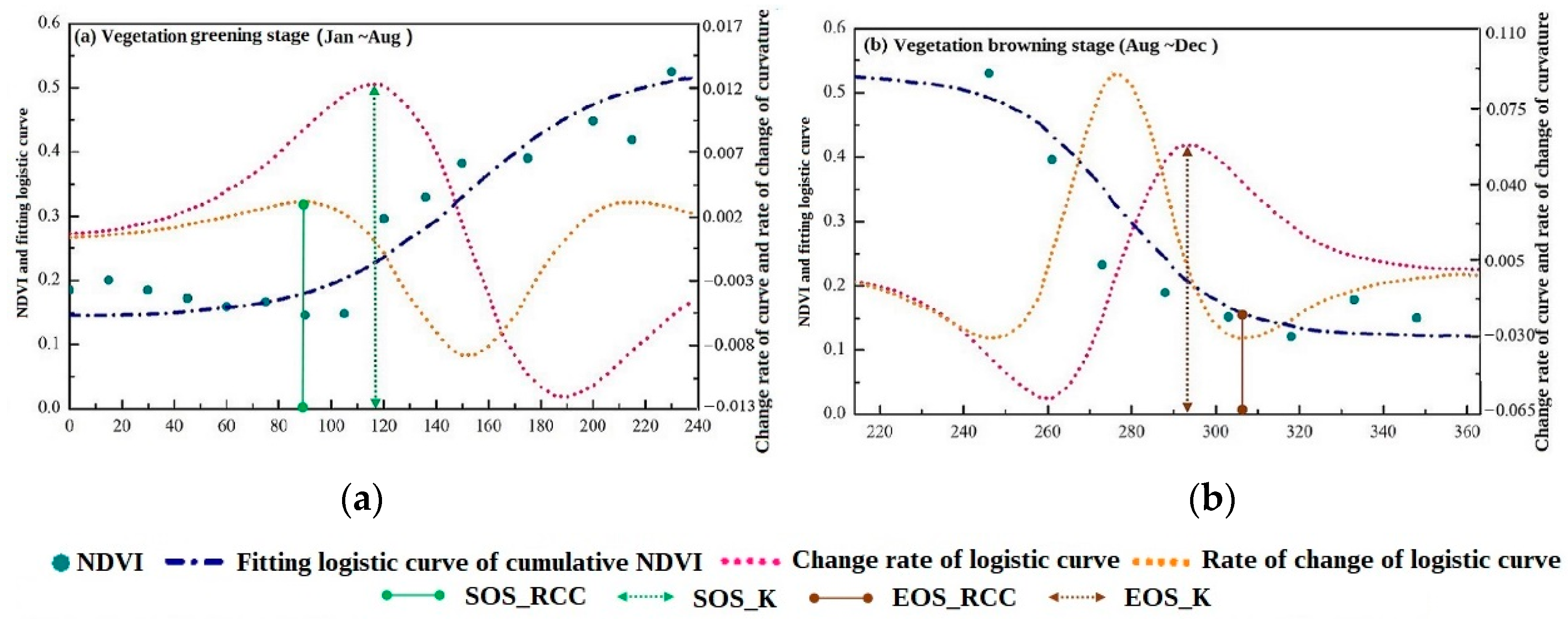
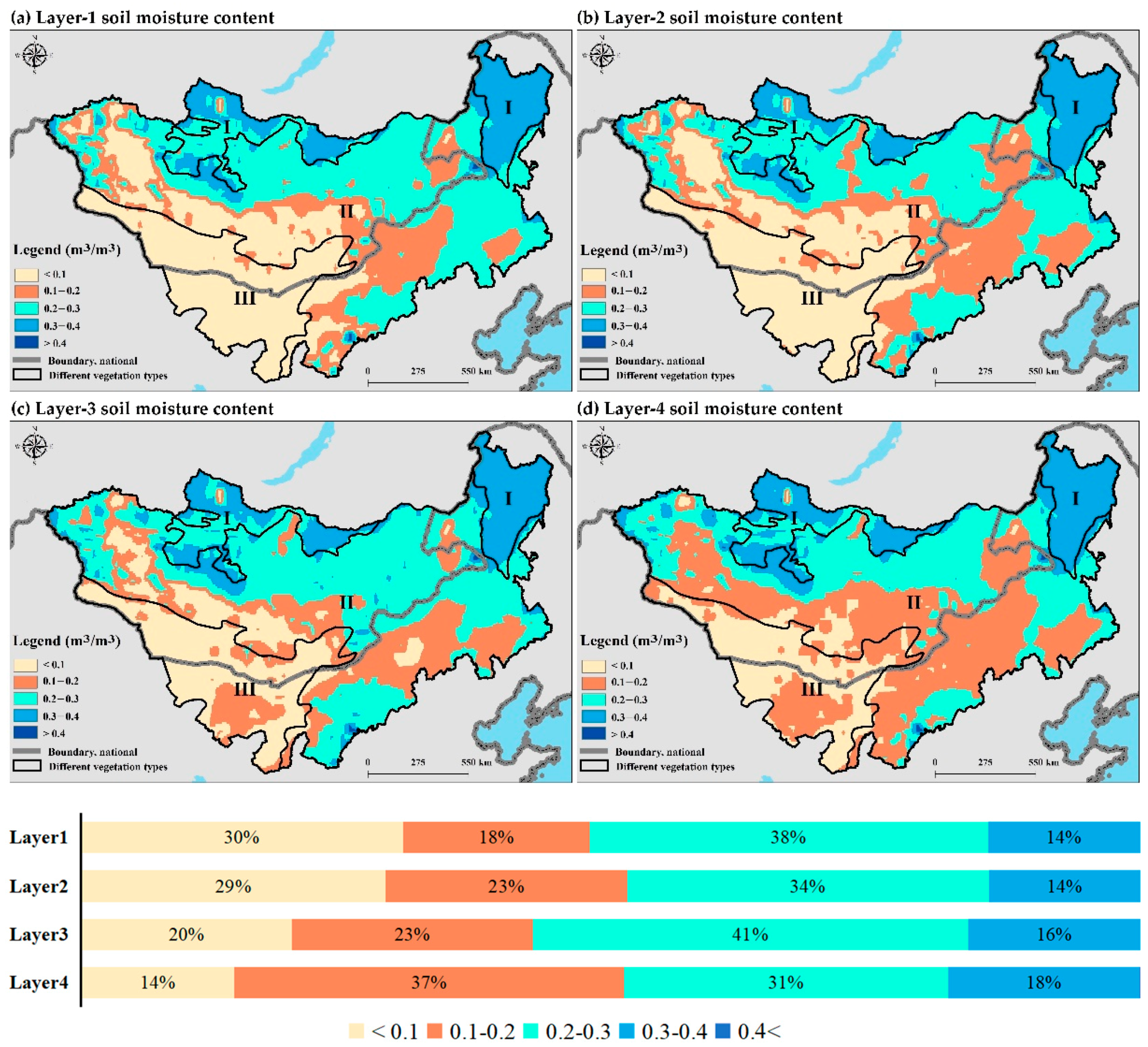
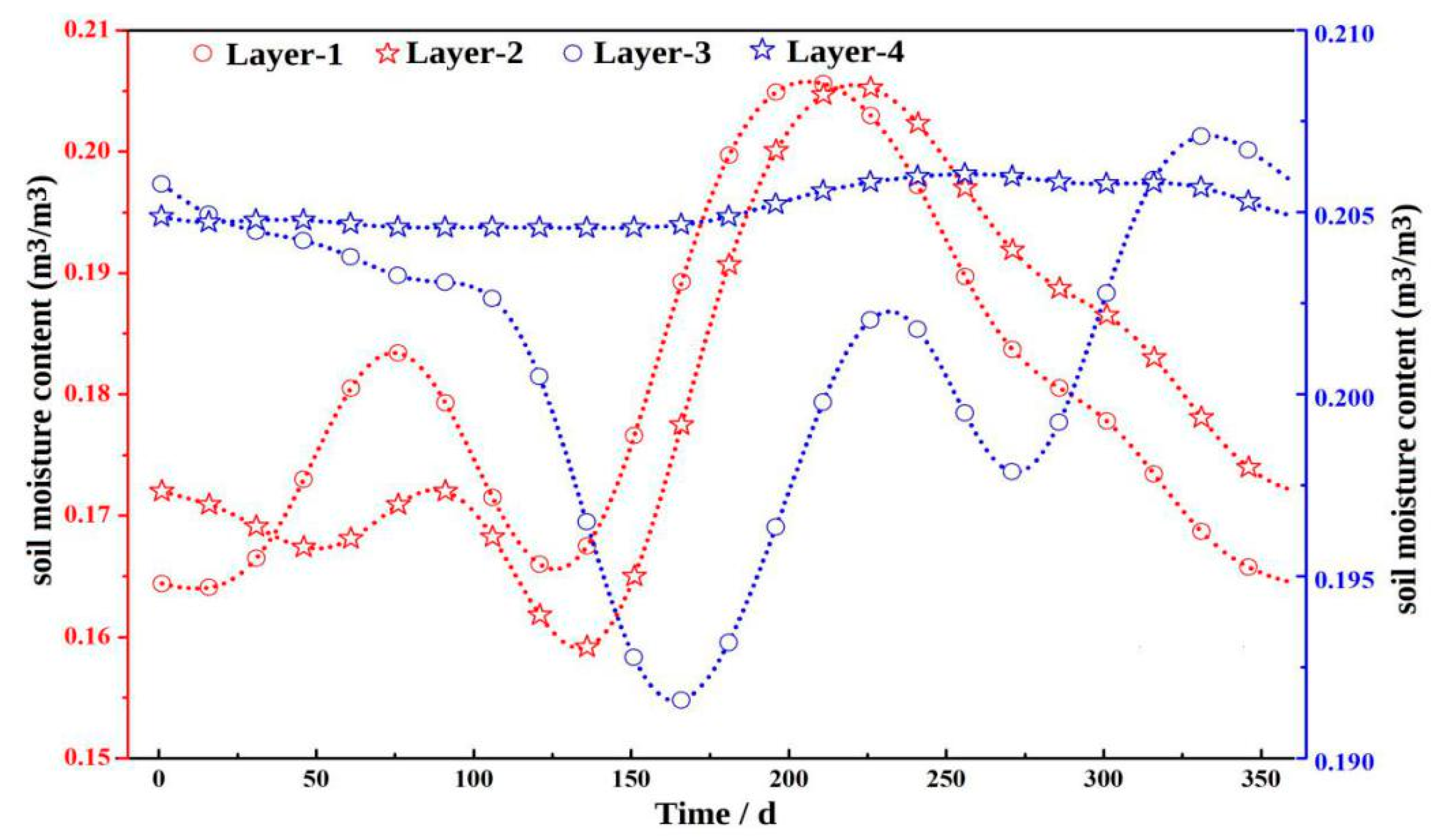
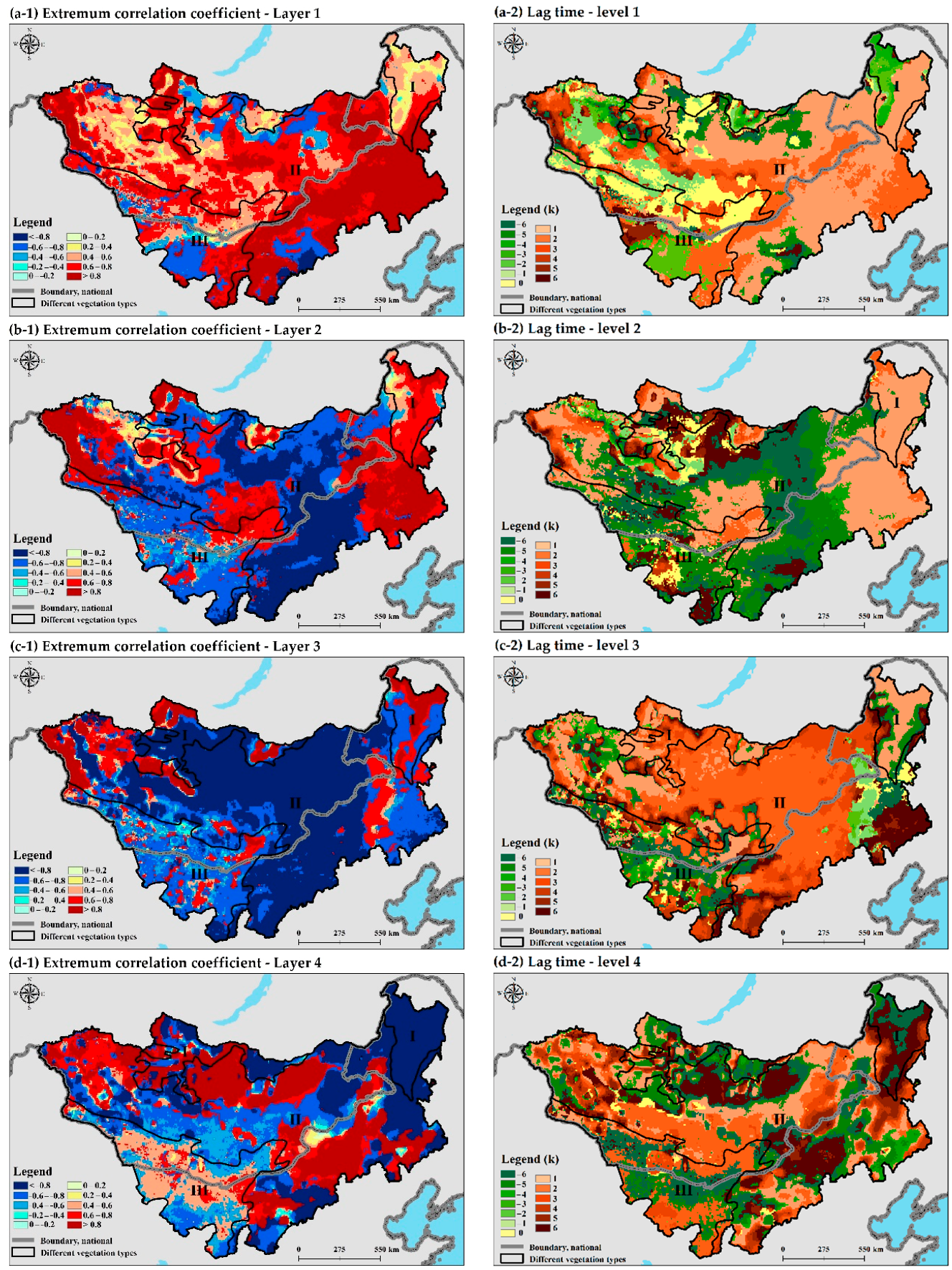
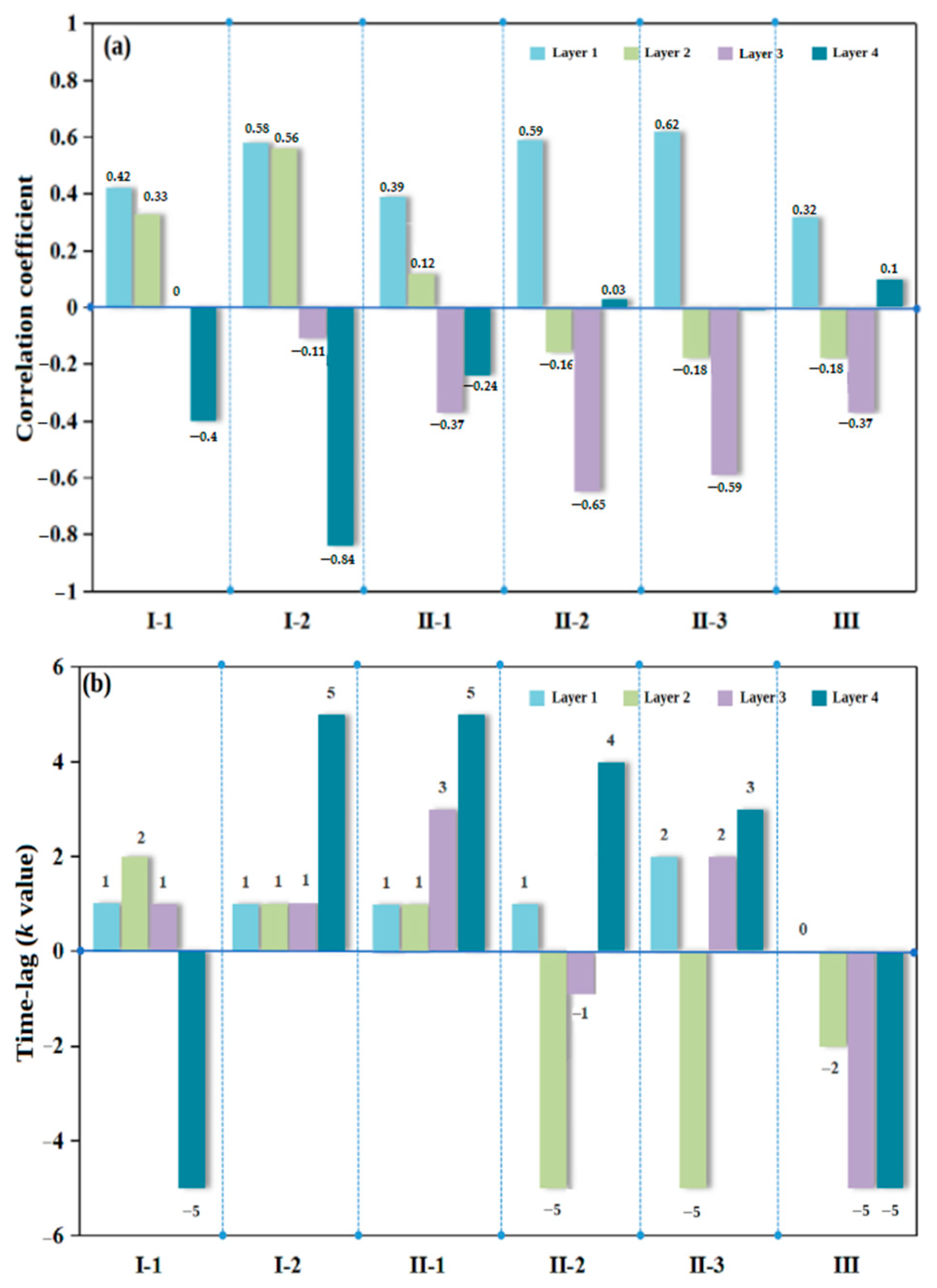

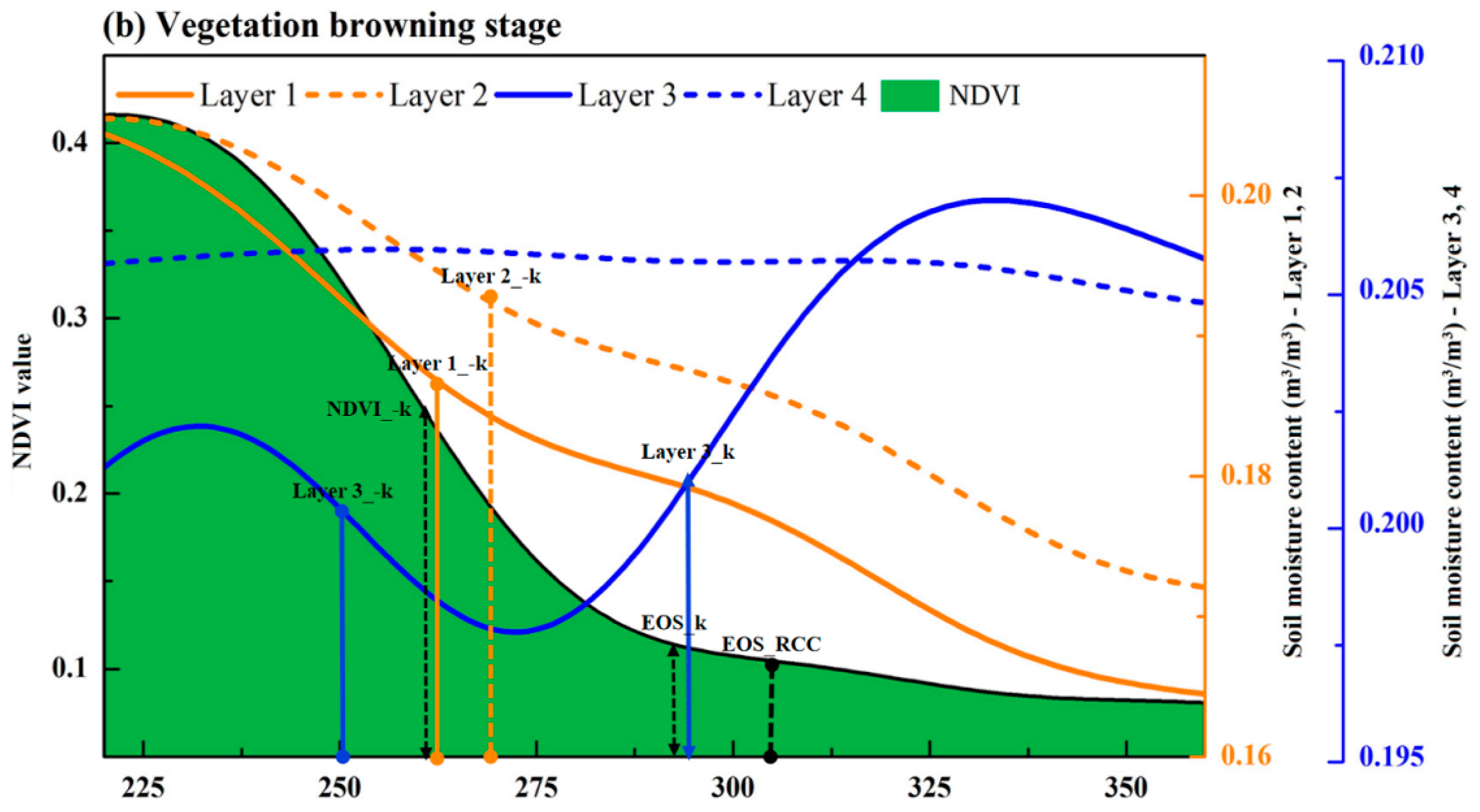
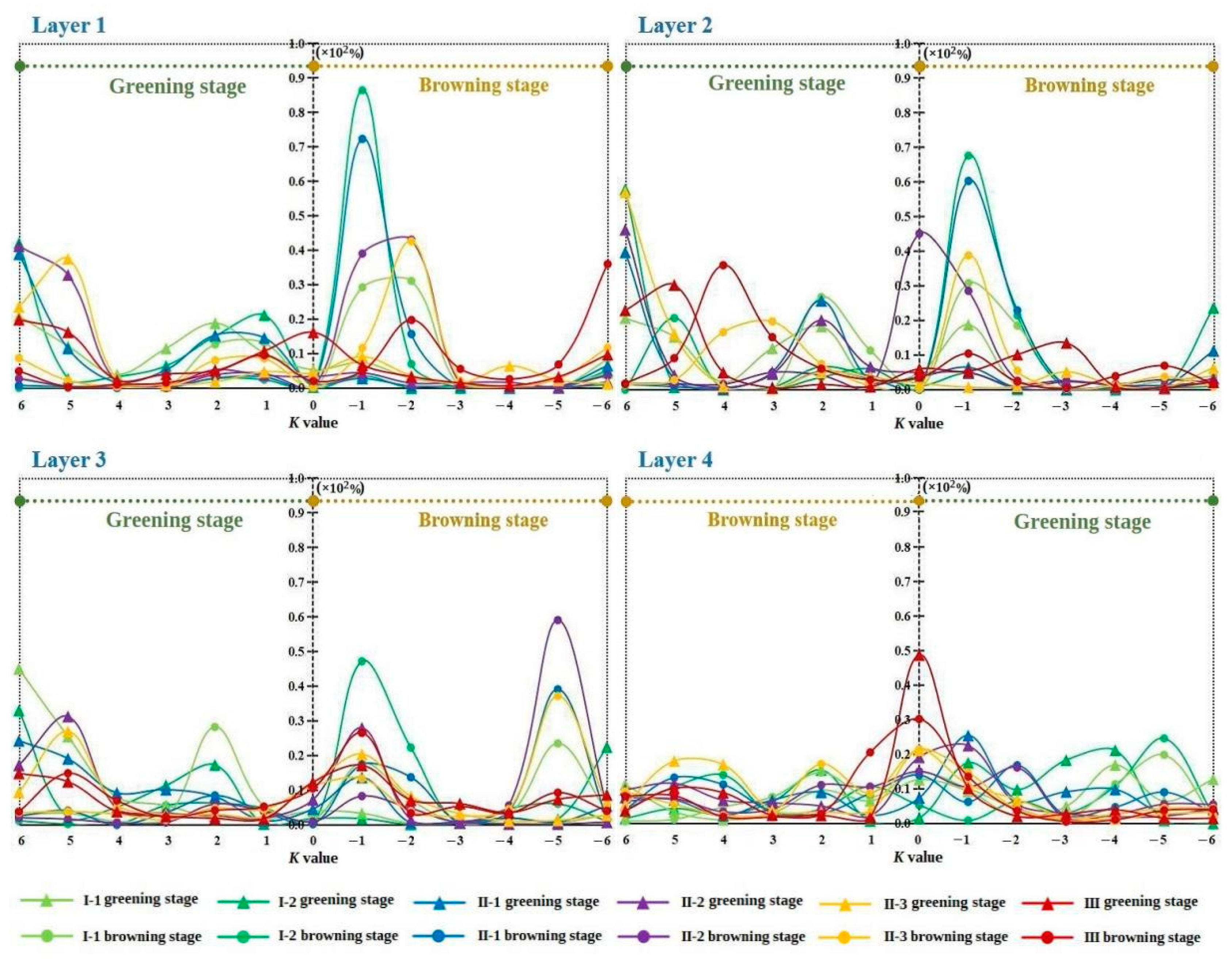
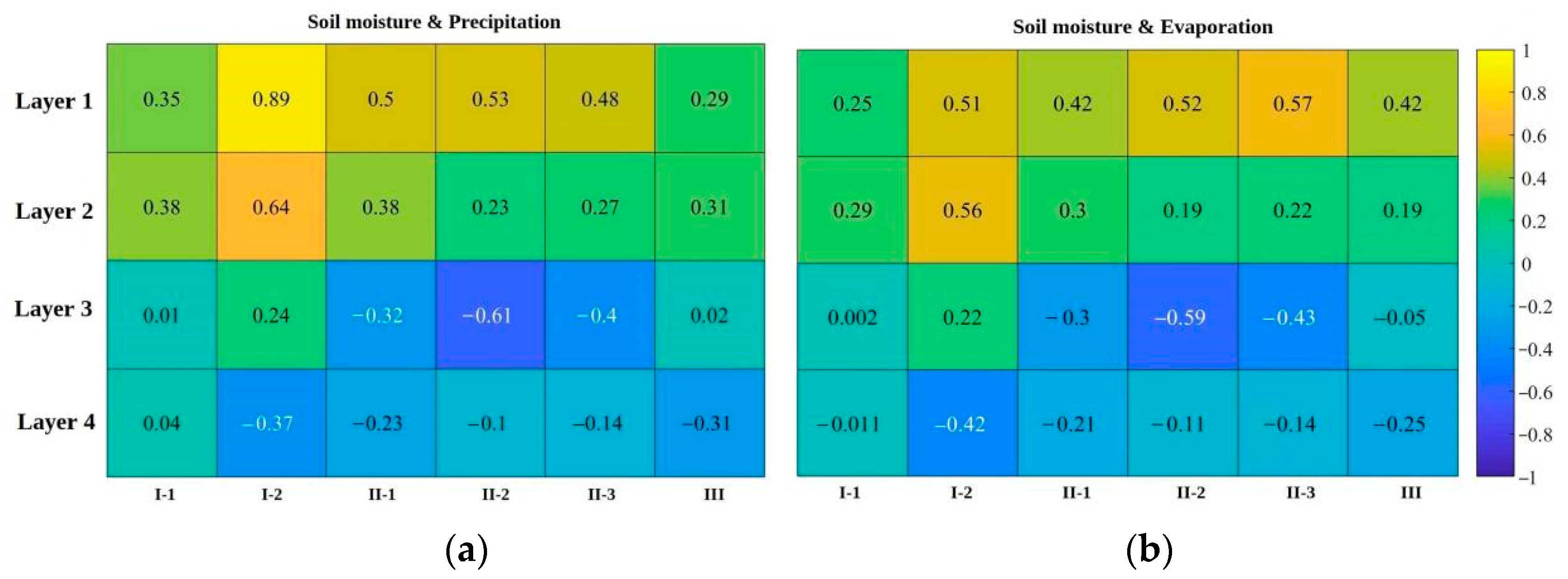
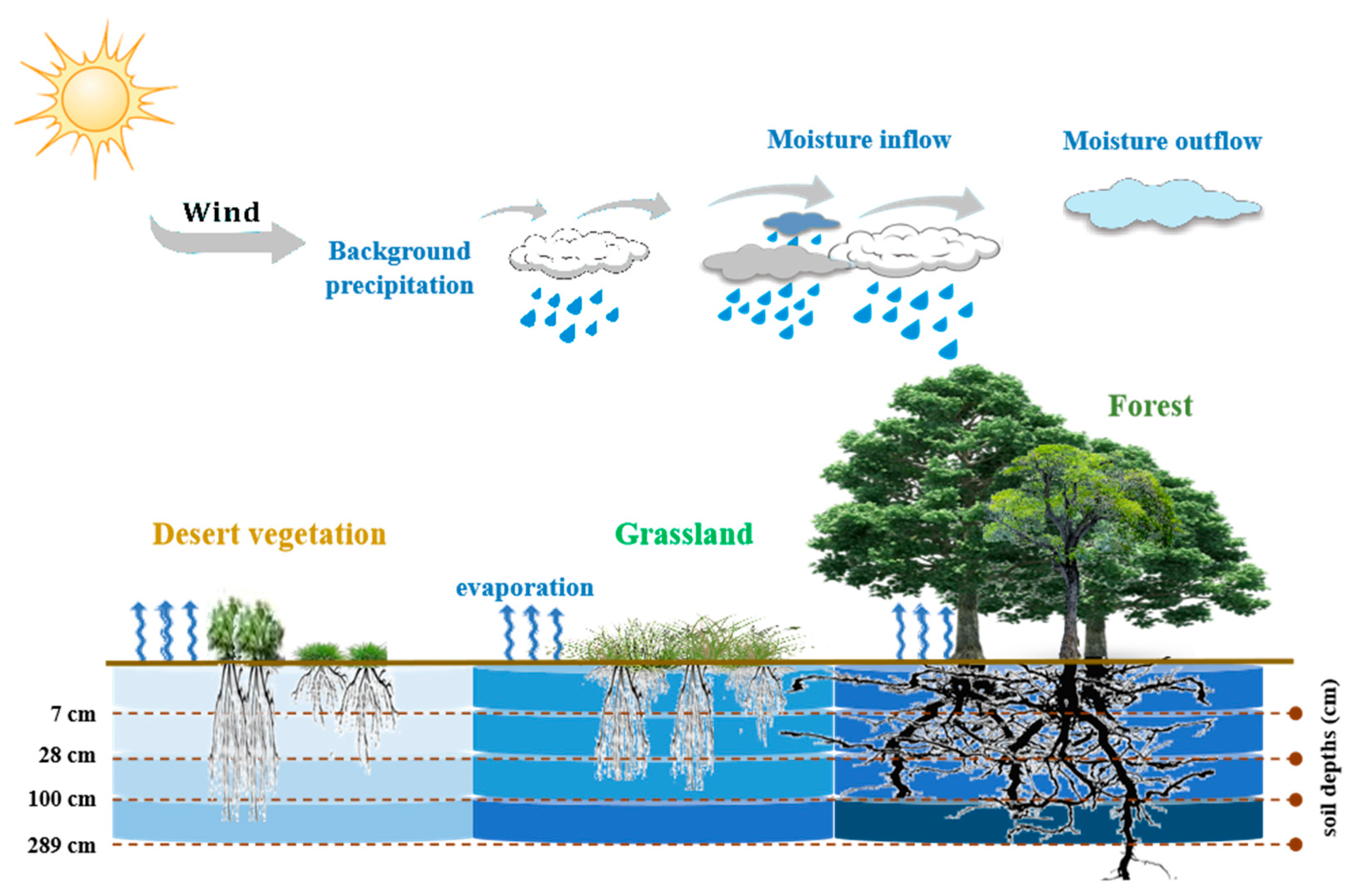
Publisher’s Note: MDPI stays neutral with regard to jurisdictional claims in published maps and institutional affiliations. |
© 2021 by the authors. Licensee MDPI, Basel, Switzerland. This article is an open access article distributed under the terms and conditions of the Creative Commons Attribution (CC BY) license (https://creativecommons.org/licenses/by/4.0/).
Share and Cite
Na, L.; Na, R.; Bao, Y.; Zhang, J. Time-Lagged Correlation between Soil Moisture and Intra-Annual Dynamics of Vegetation on the Mongolian Plateau. Remote Sens. 2021, 13, 1527. https://doi.org/10.3390/rs13081527
Na L, Na R, Bao Y, Zhang J. Time-Lagged Correlation between Soil Moisture and Intra-Annual Dynamics of Vegetation on the Mongolian Plateau. Remote Sensing. 2021; 13(8):1527. https://doi.org/10.3390/rs13081527
Chicago/Turabian StyleNa, Li, Risu Na, Yongbin Bao, and Jiquan Zhang. 2021. "Time-Lagged Correlation between Soil Moisture and Intra-Annual Dynamics of Vegetation on the Mongolian Plateau" Remote Sensing 13, no. 8: 1527. https://doi.org/10.3390/rs13081527
APA StyleNa, L., Na, R., Bao, Y., & Zhang, J. (2021). Time-Lagged Correlation between Soil Moisture and Intra-Annual Dynamics of Vegetation on the Mongolian Plateau. Remote Sensing, 13(8), 1527. https://doi.org/10.3390/rs13081527







